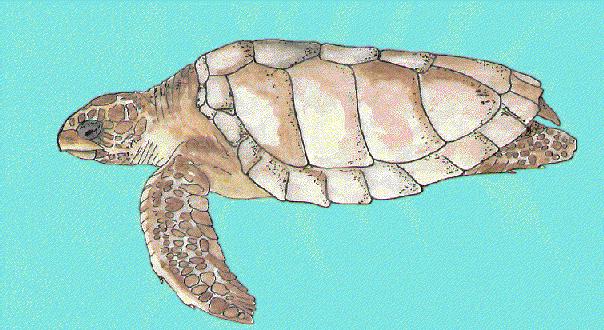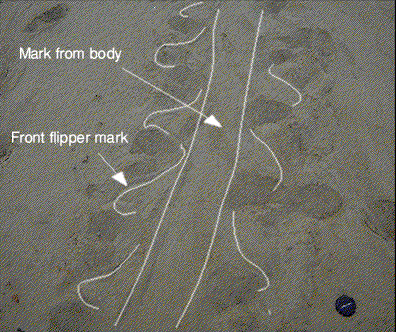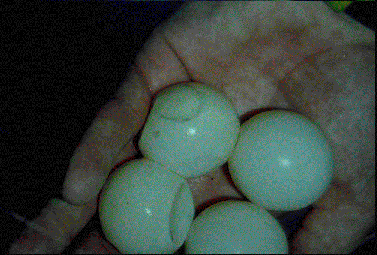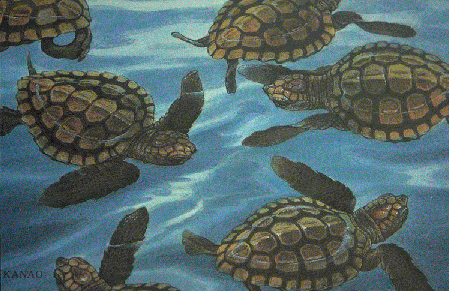
Click
on logo to go to the HOME page
 Turtle
distribution
Turtle
distribution

Species outlines
Loggerhead sea turtle
- Caretta caretta |
|
Index
Click on choice
 Browse
through Outlines
Browse
through Outlines
 Picture
of Loggerhead Sea Turtle
Picture
of Loggerhead Sea Turtle
 Size
and body mass
Size
and body mass
 Diagnostic
features
Diagnostic
features
 Geographical
distribution
Geographical
distribution
 Habitat
and Biology
Habitat
and Biology
- Typical habitats
- Migration
- Nesting areas
- Nesting periods
- Nesting behaviour
- Egg number, size
and weight
- Incubation
timing
- Size and weight
of hatchlings
- Maturity
- Courtship and
mating
- Sex determination
- Hatching
- Egg mortality
and predation
- Hatchling mortality
and predation
- Commensalism
and disease
- Feeding
 Threats
to survival
Threats
to survival

Caretta caretta
En - Loggerhead turtle; Fr
- Tortue caouanne; Sp - Caguama

 Size (cm) and body mass (kg):
Size (cm) and body mass (kg):
n.b. All figures are FAO (Food & Agriculture Organisation), unless otherwise
stated.
Figures for females were assumed to be obtained during nesting.
- Normal variation in Straight Carapace
Length (SCL) for a mature female:
- 81.5-105.3 cm; n=3502 ( n=number
in sample)
- The SCL for mature females is
always over 70 cm.
- World variation: figures, unless
stated, are for mature females
- USA (South Carolina) 84.5-103
cm: mean 92.7 cm: n=18
- USA (Georgia) mean 95.9 cm: n=110
- USA (Florida) 74.9-109.2 cm: mean
92 cm: n=661
- USA (Broward county) mean 99.6
cm: n=1203
- Mexico (Quintana) 73-109cm: mean
90.5 cm: n=423 (females)
- Mexico (Quintana) 75.3-99.5 cm:
mean 86.5 cm: n=39 (males)
- Colombia (Buritaca) 70-102 cm:
mean 87.9cm: n=77
- Greece (Zakynthos) 70-93 cm:mean
81.5 cm: n=95
- Greece (Kiparissa) mean 78.6 cm:
69-91 cm: n=68 (Margaritoulis, 1987)
- Greece (SE Cephalonia) mean 76.6
cm: n=25 (Whitmore, C., pers. comm via Groombridge)
- Turkey (Dalyan) 55-74.6 cm (Geldiay
et al., 1982) - males and females caught at sea
- Spain (Balearics) 30-65 cm: n.b.
caught on longlines at sea (Mayol & Castello Mas, 1983)
- South Africa (Tongaland) 72.8-98.5
cm: mean 86.4 cm: n=1182
- South Africa (Natal) 75.2-90.5
cm: mean 81.6 cm: n=13
- Oman (Masirah islands) mean 91.2
cm : n=1378
- Australia (Heron islands) 86-102
cm: n=?
- Japan (Shikoku) 72-107.5 cm: mean
89 cm: n=118
- Overall body mass in Kg:
- 65.7-101.4 kg: mean 75 kg: n=153
- World variation:
- Mexico (Quintana Roo) mean 65.7
kg: n=115 (females)
- Mexico (Quintana Roo) mean 101.4
kg: n=38 (males)
- Mediterranean (all) mean 105 kg:
n=? (females)
- Greece (SE Cephalonia) mean 68
kg: 52-84 kg: n=12 (Whitmore, C., pers. comm via Groombridge)
- South Africa (Tongaland) mean
106.9 kg: n=31 (females)
- South Africa (Tongaland) mean
68 kg: n=13 (males)

 Diagnostic features:
Diagnostic features:
- Heart shaped carapace, its width
about 80% of its length.
- Head is large and broad and takes
up 25% of carapace length.
- Strong horny beak and thicker
than other sea turtles.
- Carapace scutes are thin but very
hard and rough, often covered in barnacles.
- Five central plates or scutes.
- Fore flippers quite short and
thick, each with 2 claws.
- Rear flippers have 2 or 3 claws.
- Hatchlings and juveniles have
3 keels down carapace length formed from blunt spines
- Colour
- Adults are generally evenly
covered on the top (dorsal) side.
- Top colour is reddish brown
with dark streaks in South African turtles.
- Orange-cream on their flanks
- Orange-cream on underside
- Hatchlings are dark-brown
on top with pale brown margins to flippers and underside
 Geographical Distribution:
Geographical Distribution:
- Widely distributed in coastal
tropical and subtropical waters (16-20 degrees C).
- Loggerheads can wander into temperate
waters to the edge of warm currents.
- Some can migrate long distances
in warm currents - Gulf Stream in the Northern Atlantic.
- They can survive in a variety
of different environments e.g.
Brackish water of coastal lagoons and river mouths; open sea.
- Often get spring-summer feeding
grounds for juveniles, sub-adults and some adults.
- In the winter, they can remain
buried in the mud of quite deep water.
- Limit of distribution is temperature
dependent.
- Rarely survives in water below
10 degrees C.
- In cold waters they become stunned
and drift helplessly.
- In some warm years they can get
into northern waters e.g. Murmansk and Barent Sea.
 Click
here to go to World Distribution Maps
Click
here to go to World Distribution Maps

 Habitat and Biology:
Habitat and Biology:
- Typical habitats:
- Mainly found on the continental
shores of warm, shallow seas. Also found around some islands such as Zakynthos
in Greece. Most aggregate just off nesting beaches prior to the nesting season
(the time varies greatly depending on location). Loggerheads are the only
Sea Turtles that can nest successfully outside of the tropics although the
water temperature has to be above 20 degrees C.
- Migrations:
- After nesting, adults disperse
to feeding grounds. Outside of the Mediterranean, migratory routes are not
clearly defined although hatchlings are thought to follow the warm currents
such as the Gulf Stream. Hatchlings and juveniles often congregate at sea
fronts (the meeting of oceanic currents) where food and floating animals gather.
Even some suggestions that they get trapped in these currents and only emerge
back on their natal beaches once the circuit has been completed - mature and
ready to breed!
- Loggerheads can migrate across
large distances: one that had nested and been tagged on a beach in Florida
was recaptured less than 10 months later, 2,400 km away in the Dominican Republic!
- The time elapsed (a year or more)
that the hatchlings stay feeding in these areas are called the Lost years.
They are thought to drift within the large mats of sargassum weed.
- Mediterranean loggerheads rarely
leave their enclosed sea and are thought to be a genetically isolated population.
There is some evidence of recruitment via Gibralter and Suez, although this
is probably very small. Loggereheads are found all over the Mediterranean
although most activity occurs in the Eastern part of the Mediterranean and
there is firm evidence that there are important wintering areas located off
the south east coast of Turkey (Groombridge).
- Nesting areas:
- Outside of the Mediterranean,
there are several major nesting grounds. The major part of the world's nesting
sites are located in Southeastern USA with annual nest counts of 28,000 and
Oman with 30,000. Elsewhere, there are 2,000 nests in Brazil, 1,000 in South
Africa and 2,000 in Australia: smaller nesting sites also exist in numerous
other locations. Nests in the Indian Ocean are virtually unknown.
- In the Mediterranean, the loggerhead
is the commonest nesting turtle with Greece hosting the highest nesting populations
of 2,000+. Sekania beach on Zakynthos Island, Greece has the highest density
of nests anywhere in the world. Recent surveys have also shown significant
nest numbers in Turkey and Libya.
- Nesting periods:
- This usually occurs in spring
or summer, depending upon location.
- Caribbean - April to early August
- NW Atlantic - April to September
- SW Atlantic - April to August
- Eastern Mediterranean - June to
September
- Senegal - July to October
- South Africa - October - February
- China - April to August
- Australia - October to April
- Nesting behaviour:
- The female usually come ashore
at night ( records suggest that this may well have happened during the day
in undisturbed sites). Loggerheads are said to be highly philopatric:
returning to the same stretch of coastline to nest each year, probably to
the same area where they originally hatched. Some populations are more site
specific than others. Nesting sites are only found on sandy, shelving beaches.
The nest is usually made at the top of the beach and about 45 cm deep and
flask shaped. After laying, she will cover the nest with sand and attempt
to camouflage by scattering sand. She will then return to the sea. Loggerheads
have a characteristic track as shown in the picture below.

Track is wavy with alternate flipper marks. The outlines are marked in
white.
The turtle is moving down the picture!

If you are viewing
this page with a browser that supports multi-part GIF sequences (ie Netscape
V2 or better), click on the picture to the right of turtle tracks to see
an animated nesting sequence. The sequence shows a female camouflaging her
nest after egg laying, and her return to the sea.

- Egg number, size and weight:
- Most females nest between 2 or
3 times in a season, with a gap of about 14 days between each laying. They
lay 40 to 190 eggs, depending on the individual. A single female could lay
560 eggs per season. The reproductive cycle using involves laying every two
or three years although some will lay every year. Clutch sizes vary greatly
as shown below.
- USA (N. Carolina) mean 123: 86-159
eggs: n=36
- USA (S. Carolina) mean 126: 64-198
eggs: n=71
- USA (Georgia) mean 120 eggs: n=2827
- USA (Florida) mean 107: 53-174:
n=1928
- USA (Merrit Island) mean 12: 82-173:
n=64
- Greece (Zakynthos) 52-114 eggs
- Turkey (Med. coast) mean 93: 55-160:
n=50
- Egg size is usually proportional
to the size of the turtle e.g. smaller eggs from smaller turtles.
- Mean diameter ranges from 34.7-55.2
mm.
- Eggs in one clutch are very similar
in size although a few can be smaller. This contrasts to the Leatherback Sea
Turtle, which has a great variation in egg size within one clutch.
- Egg weight varies from 26.2-46.8
g.

Eggs shed by female in Laganas Bay, Zakynthos - Greece
- Incubation time:
- Incubation time varies with beach
latitude.
- USA (Florida) mean 68 days (Lat-26)
- Mexico (Quintano Roo) mean 56
days (Lat-19)
- Turkey (Med. coast) mean 57 days
(Lat-36)
- Greece (Zakynthos) mean 57 days
(Lat-38)
- South Africa (Tongaland) mean
68 days (Lat-30)
- Japan (Hiwasa) mean 58 days (Lat-34)
- There is some considerable degree
of variation on any one beach, due to local environmental conditions. Some
sites also show considerable variation from one year to the next.
- Size and weight of hatchlings:
- Size and weight of the hatchlings
correlates directly to the egg size. The mean Straight Carapace Length (SCL)
ranges from 33.5-55 mm. Weights vary between 18.8-21.1 g.
- Maturity:
- The age of first maturity is not
clear but research in captive specimens suggests between 6 to 20 years. Figures
taken from the wild involving back calculations ( recapture data from tagged
females) suggests 12 to 30 years before maturity. The main differenece probably
depend upon latitude and available food.
- Courtship and Mating:
- Unlike most other species of Sea
Turtle, courtship and mating is not performed near the nesting beaches but
during migration from the feeding to breeding grounds. Copulation is most
accomplished whilst floating but does occur underwater. Several matings make
take place and there is evidence that sperm from several males may be stored
in the oviducts. All eggs for one season can be fertilised from this stored
sperm. Mating normally takes place a few weeks before laying.
n.b. recent observations in Dalyan ( June Haimoff, Conservationist), Turkey
and in Kephalonia, Greece suggest that males do move close in shore to mate
and even in fresh water lagoons linked to the sea. Reports from Kephalonia
even suggest that males seem to set up 'mating' areas which might further
suggest some selection process? ( Kephalonia Marine Turtle Project - Tom
Stringell)

- Sex determination:
- Incubation occurs between 26-32
degrees c. Evidence that sex determination is temperature dependent.
- Male-biased in the cool. Key or
pivotal temperature in which sex ratio is 1:1 is 30 degrees c for the
Loggerheads. There is some evidence that this key temperature varies from
location to location.
- Hatching:
- Hatchlings emerge at night, the
peak time between 21:00 and 02:00 hours. On cool cloudy days this time will
be much later. Together, the hatchlings dig their way out of the nest. Usually
emerging at night, the group makes its way down the beach and enters the sea.
This race to the sea is important for the hatchlings' biological cycle.
- Egg mortality and predation:
- In some locations, predation on
eggs can be extremely high as shown by work carried out on Dalyan Beach in
Turkey (Erk'akan (1991). Out of an estimated 17,254 eggs laid, 12,078 and
1,725 were predated by foxes and ghost crabs respectively. (some of the ghost
crab predation was on recent hatchlings.) This predation rate is estimated
as high as 70%. On the Northern shores of Cyprus, predation rates are much
lower - 38% predated, 8% hatched and predated and 31% unknown (Broderick 1995)
Interestingly, Loggerhead turtles are more prown to predation than Green
turtles because their eggs are located nearer the surface.
- Hatchling mortality and predation:
- Lights near the beach disorientate
them, causing the hatchlings to wander in the wrong direction. If this happens,
they will die of dehydration or be eaten by predators. The highest mortality
occurs at this stage. This migration to the sea is made more difficult by
vehicle tracks and sand pits made during the day by tourists. They are too
small to climb out and soon die of dehydration in the hot sun of the morning.
Many eggs are destroyed by natural activities such as erosion or sea overwash
although many eggs are destroyed in the nest by bacteria, fungi and other
predators such as racoons (Florida 40-50% are destroyed by racoons, skunks
etc). In Zakynthos, Greece, there has been some damage caused by plant roots
entering nests and from other females damaging nests on high density laying
beaches such as Sekania. Mortality varies greatly from site to site.
- Little is known about predation
on juveniles and adults but they are generally too,large and well armoured
for most predators. Big carnivores like sharks do take turtles. Adults when
attacked, present their flanks to the predator and prevent biting.
There have been few quantitative stomach content studies on most sharks although
qualitative studies have shown that turtle parts are common in big sharks
such as the tiger. One recent study showed a link between the increase in
viral infections of sea turtles and the decline in shark numbers: there is
speculation that sharks predate on sick turtles? Unfortunately, in Hawaii,
where tigers seem to be on the increase, turtle infection is high.(email on
the CTURTLE network Oct 1996 Robins J)
Monk seals in Greece are also predators of loggerhead turtles, although
the numbers they kill are small (Margaritoulis.D, 1995).

Hatchlings swimming out to sea - the Lost Years
- Commensals and disease:
- Loggerheads carry more epibiontic
animals than the other species of Sea Turtle. There is one barnacle which
is specific to the loggerhead:
- see the picture below.

Barnacle on carapace - 35 mm across
Recent work has suggested that barnacles can cause harm to the turtle and
there is a possible correlation between the health of the turtle and the
number of barnacles it carries on its carapace. ( email via the CTURTLE
network Beasley J, sept. 1996) Leeches can cause skin damage and secondary
infection (this may cause the tissue to degenerate which is then known as
a papillomae).
The most important recent disease
of sea turtles, especially Greens, is a disorder known as fibropapillomatosis.
The disease is characterised by one or more fibrous tumours, which are located
on areas of soft skin. The tumours are debilitating and can prove fatal.
The cause is unknown but a viral infection is suspected. Research is underway
in a number of Universities. The disease is becoming more common.

- Feeding:
- Feeding changes with age but loggerheads
are mainly carnivorous. Loggerheads will eat almost anything and show little
real food preferences. They have powerful jaws and can deal with many food
typres. Their diet has been shown to include:
- Jellyfish
- Crustaceans ( lobsters, crabs
and shrimps)
- Molloscs ( clams, mussels, conchs
etc)
- Encrusting animals attached
to reefs and rocks
- Some stomach content analysis
has revealed weed and even plastic bags mistaken for jelly-fish. Oil droplets
have also been found in the stomachs of hatchlings which have possibly been
confused as potential food particles. (Wietrich, B. 1994)
 Threats to survival:
Threats to survival:
- The threats to Loggerheads vary
from region to region, although four key areas can be identified.
- 1. Loss of habitat -
- due to commercialisation, including tourism and idustrialisation.
- 2. Accidental capture by fishing
activities -
- due to long line fishing and shrimping
- 3. Pollution -
- due to industrial effluent, plastics etc.
- 4. Human predation -
- due to egg collecting.
- Meat eating: low due to low palatability of the meat
- Turtle-shell: low as poor quality


![]() Turtle
distribution
Turtle
distribution![]()
![]()

![]() Turtle
distribution
Turtle
distribution![]()
![]()
 Browse
through Outlines
Browse
through Outlines
 Picture
of Loggerhead Sea Turtle
Picture
of Loggerhead Sea Turtle
 Size
and body mass
Size
and body mass
 Diagnostic
features
Diagnostic
features
 Geographical
distribution
Geographical
distribution
 Habitat
and Biology
Habitat
and Biology
 Threats
to survival
Threats
to survival

 Click
here to go to World Distribution Maps
Click
here to go to World Distribution Maps






 Threats to survival:
Threats to survival: